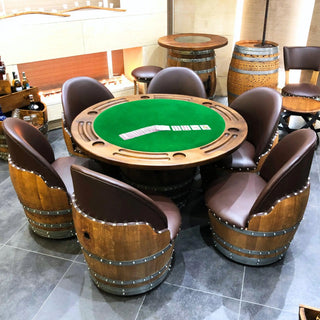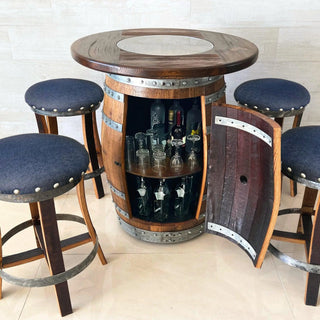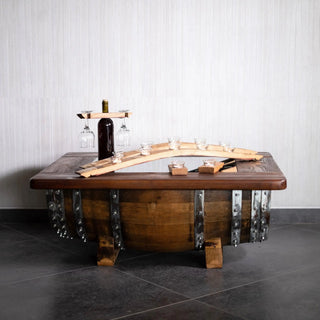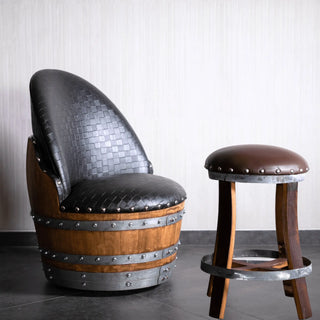How Barrel Tables Are Made: From Wine Cellar to Living Room
The first time I walked into a workshop filled with old wine barrels, I’ll be honest — I didn’t see furniture.
I saw dust. Age. Rings of red wine staining the oak. Scuff marks from forklifts. Metal hoops slightly rusted with time.
But the craftsman beside me smiled like he was looking at treasure.
He ran his hand over the wood and said quietly,
“You see junk. I see stories.”
That stuck with me. Because that’s exactly what these barrel tables are — stories that have lived, aged, and been reborn.
Every Wine Barrel Coffee Table or Barrel End Table from Oak Wood Wine Barrels starts its journey deep underground, in a wine cellar or distillery. There, in the dark, it holds the weight of something beautiful — wine, whiskey, patience.
And then, one day, when its job is done, it becomes something else entirely.
Let me tell you how that happens — and why it still gives me goosebumps every time I watch it unfold.
It Begins in a Place That Smells Like Time
If you’ve ever been inside a winery’s barrel room, you know the feeling. It’s cool and quiet, and the air smells like earth, oak, and old secrets.
Every barrel sitting there is made from solid oak — chosen for its strength and its ability to breathe. The wood gives the wine or whiskey its flavor, its depth, its warmth.
Over years, the barrel changes too. It takes on the color of the drink inside it — purple tones from red wine, deep amber from bourbon. You can’t rush that process. You can only wait.
By the time that barrel retires, it’s absorbed more than just flavor — it’s absorbed time.
And that’s when it gets a new chance at life.
The Rescue: Where the Past Meets Patience
When Oak Wood Wine Barrels acquires retired barrels, they arrive with all their scars showing — scratches, stains, dents, maybe a faint smell of whiskey that lingers like a memory.
That’s what I love about them. They come in imperfect, and the craftsmen don’t try to erase that. They honor it.
The process begins with taking each barrel apart — carefully, patiently. The metal hoops are loosened. The staves (those curved oak slats that make the barrel’s shape) are gently pulled free.
It’s not done with machines. It’s done by hand, because this kind of work demands respect.
I remember watching an older craftsman once pause mid-sanding, his hand hovering over a wine-stained stave.
He said, “You see this red mark? That’s fifteen years of Cabernet.”
And he smiled — like he wasn’t just sanding wood, but preserving memory.
Cleaning and Bringing Out the Character
Once disassembled, the wood is cleaned and sanded. Not too much — just enough to smooth the surface and remove residue while keeping its soul intact.
You can still see the faint shadows of its past life — the soft burgundy blush of wine, the darker grain from where liquid soaked into the oak.
When they sand it by hand, the scent that fills the air is something you never forget. It’s rich, smoky, faintly sweet. You can smell the vineyard, the barrel house, the oak forests it came from.
This is where the story changes. The oak that once aged wine now gets ready to age gracefully in your home.
The Craft: Turning Memories into Furniture
This part feels almost like choreography — every cut, every curve, every joint is deliberate.
Depending on the table design, some barrels are cut in half to form a coffee table base. Others stay whole, their curved body supporting a new tabletop. Some even become Barrel Coffee Table Chests with hidden compartments inside.
There’s no rush, no mass production. Every decision is made by eye, by feel.
If the wood bends slightly, the craftsman adjusts the design. If a stave has an especially beautiful grain pattern, they might make it the centerpiece.
Watching it come together is like seeing a sculpture emerge from something raw and unassuming.
You start to realize — this isn’t recycling. It’s resurrection.
The Moment It Comes to Life
The moment the finishing oil touches the oak, everything changes.
You can literally see the wood wake up.
The grain darkens. The red wine stains start to glow like veins of ruby. The scent of oak deepens into something warm and full.
I’ll never forget the first time I saw a finished Wine Barrel Table in the sunlight. The light bounced off the curved staves like water — gold, amber, caramel.
It was breathtaking.
The team at Oak Wood Wine Barrels doesn’t rush this part. They use natural finishes — oils, waxes, and sealants that protect without smothering. You can still feel the wood. You can still sense its life under your fingertips.
That’s the magic — it’s not coated, it’s nurtured.
The Perfect Blend of Old and New
These barrel tables aren’t relics. They’re living pieces of design.
Some come with glass tops so you can peer inside and see the original barrel markings. Others hide clever compartments beneath the surface — storage for remotes, books, or even a secret stash of wine corks (no judgment).
Every detail — from the reclaimed iron hoops to the curved oak base — reminds you that this piece has been something before, and it’s still becoming something now.
It’s rustic. It’s elegant. It’s timeless.
And it doesn’t just sit quietly in a room — it starts conversations.
The Final Stop: Your Home
When the table finally leaves the workshop, it’s not factory-fresh. It’s soul-fresh.
You can feel it the moment you bring it into your space. The room just feels warmer. More grounded. The oak carries a presence that you can’t quite describe — steady, calm, real.
Every time I set a mug down on mine, I find myself tracing the grain with my finger. Sometimes I wonder what vineyard it came from. Whose hands rolled it into a cellar. What wine rested inside before it came to me.
It’s humbling, honestly — knowing you’re part of its story now.
That’s what makes barrel furniture so different. It’s not just décor. It’s a piece of life, passed forward.
Why It Means Something
The team at Oak Wood Wine Barrels doesn’t just make tables — they carry forward craftsmanship that feels almost forgotten.
Each barrel they touch is a small act of reverence — for wood, for time, for the stories we keep.
And maybe that’s why these tables feel so at home wherever they go. They’ve already been places, held things, waited quietly for years.
Now, they hold your coffee, your laughter, your late-night conversations.
The oak’s job hasn’t changed — it still holds moments worth keeping.
Our Links
- Shop Authentic Barrel Coffee & End Tables
- Explore How Reclaimed Oak Furniture Is Made
- Discover Barrel Tables with Real Cellar History
Other Resources to Explore
- Smithsonian – The Art of the Cooper: Keeping Barrel Craft Alive
- Wine Enthusiast – The Life Cycle of the Oak Barrel
- Architectural Digest – How Reclaimed Wood Became Modern Luxury
Every barrel table has two stories: the one it lived, and the one it’s about to live with you.
It spent years in the dark, filled with wine or whiskey. Now it lives in the light — in your home, holding laughter, coffee, and memories instead.
It’s proof that beauty doesn’t fade with time — it transforms.
And that’s why, every time I look at mine, I can’t help but think:
If oak could talk, this one would have a lot to say.
Disclaimer:
This article is for inspiration and education only. All Oak Wood Wine Barrels furniture is handcrafted from authentic reclaimed oak barrels — each piece unique, with its own tone, markings, and character. No two are ever the same. Product details and finishes may vary. By choosing reclaimed oak, you’re helping preserve sustainability, craftsmanship, and the art of giving history a home.




